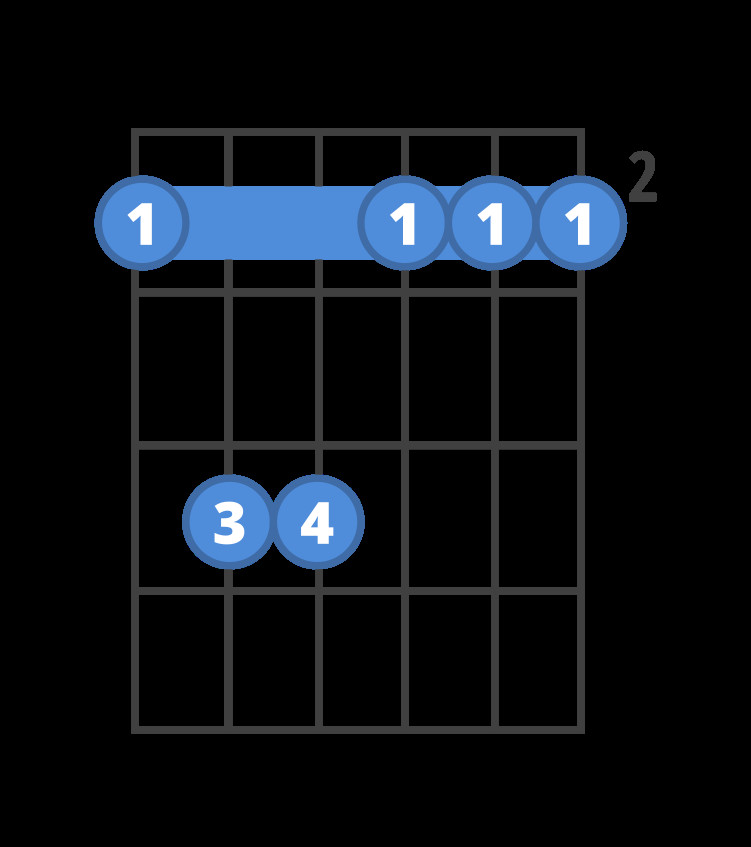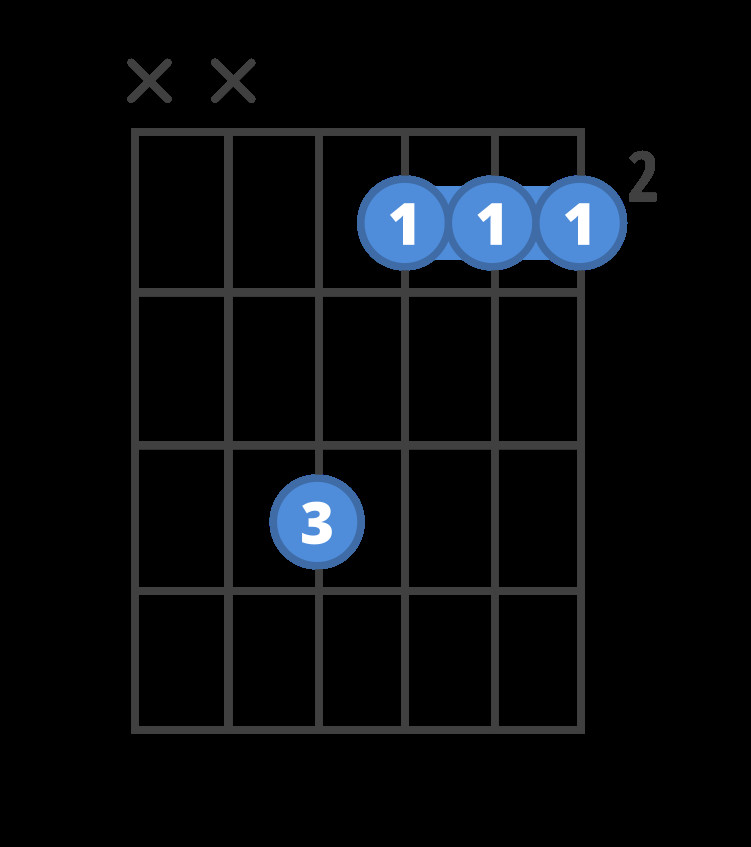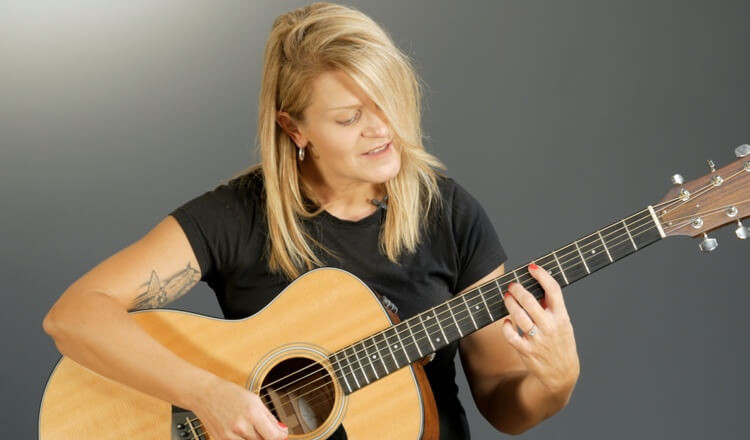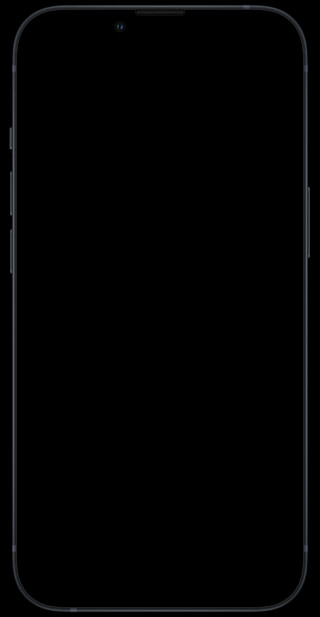The F#m (F sharp minor) guitar chord is often a stumbling block for beginner guitarists. If you’ve been searching for “Guitar Chords F#m” and finding yourself frustrated, you’re not alone. It’s actually one of the most frequently looked-up chords, and for good reason.
The most common version of the F#m chord involves a barre, where one finger presses down multiple strings at once. Barre chords require finger strength and dexterity that take time to develop. But don’t worry! There are multiple ways to play the F#m chord, including some that skip the barre entirely, making it accessible even for beginners.
Let’s explore three different ways to play the F#m chord, starting with the most challenging and progressing to the easiest versions.
The Standard F#m Barre Chord
This is the classic, “textbook” version of the F#m guitar chord. It’s a great chord to learn eventually, as mastering barre chords opens up a whole new world of guitar playing. However, if you’re just starting out, it can be quite tricky.
 Diagram of the standard F#m guitar chord, a barre chord requiring strength and practice.
Diagram of the standard F#m guitar chord, a barre chord requiring strength and practice.
Here’s how to form the standard F#m chord:
- Place your index finger across all six strings at the 2nd fret. Ensure you press down firmly enough for all strings to ring clearly.
- Position your ring finger on the 4th fret of the 5th string (A string).
- Place your pinky finger on the 4th fret of the 4th string (D string).
- Strum all six strings.
The challenge here is the barre. It requires consistent pressure across all strings with your index finger. If you find this version difficult, don’t get discouraged. Barre chords take practice, and there are easier alternatives to get you playing the F#m chord right away. For a deeper dive into barre chords, check out resources specifically dedicated to mastering them.
The Easier Mini Barre F#m Chord
Barre chords become significantly easier when you reduce the number of strings you need to barre. This “mini barre” version of the F#m chord only requires you to barre the top three strings, making it much more manageable for developing fingers.
 Diagram of the mini barre F#m guitar chord, an easier barre variation for beginners.
Diagram of the mini barre F#m guitar chord, an easier barre variation for beginners.
Here’s how to play the mini barre F#m chord:
- Place your index finger across the first three strings (B, G, and high E) at the 2nd fret.
- Position your ring finger on the 4th fret of the 4th string (D string).
- Strum only the thinnest four strings (from the D string down to the high E string). Avoid strumming the lower E and A strings.
This version is easier to fret and still provides the essence of the F#m chord sound. It’s an excellent stepping stone for practicing barre techniques and building finger strength without the full six-string barre.
The No Barre F#m Chord: The Simplest Version
For the absolute easiest way to play an F#m chord, we can eliminate the barre completely! This version only uses the top three strings and is perfect for beginners who want to play songs with F#m without the barre chord struggle.
- Place your index finger on the 2nd fret of the 3rd string (G string).
- Place your middle finger on the 2nd fret of the 2nd string (B string).
- Place your ring finger on the 2nd fret of the 1st string (high E string).
- Strum only the thinnest three strings (G, B, and high E). Make sure to avoid strumming the thicker strings (E, A, and D strings).
This no-barre F#m chord is the simplest to play and allows you to start incorporating the F#m sound into your playing right away. While it’s a partial chord, it effectively conveys the F#m tonality, especially in simpler song contexts.
Practice & Further Learning
Learning guitar chords, especially barre chords like the standard F#m, takes practice and guidance. If barre chords feel intimidating, remember you’re not alone! Many beginners find them challenging.
 Image promoting barre chord lessons, encouraging users to learn more.
Image promoting barre chord lessons, encouraging users to learn more.
To demystify barre chords and build your skills, consider exploring dedicated barre chord lessons. These resources can provide structured exercises and tips to help you master barre chords efficiently and eliminate fret buzz.
Practice Smarter with ChordBank
To truly solidify your F#m chord and transition smoothly between chords, consistent practice is key. Repetition and muscle memory are essential for making chord changes feel natural.
 iPhone displaying ChordBank games, suggesting interactive practice methods.
iPhone displaying ChordBank games, suggesting interactive practice methods.
Interactive practice tools can make learning more engaging and effective. ChordBank offers games and flashcards specifically designed to help you learn and practice guitar chords, including F#m.
Games for F#m Chord Practice
Games like ChordPOP! and Blackjack within the ChordBank app provide a fun way to drill the F#m chord. As you play these games, you’ll repeatedly form the F#m chord and other common chords, reinforcing your finger placement and transitions.
[
ChordPOP!: F#m »
Play chords to fire darts and pop balloons!](/o/game/?k=Z23C7vy>x=2xYJeQ8NxY)
[
Blackjack: F#m, A, D, and E »
Play chords to deal cards and place bets!](/o/game/?k=Z1OcUhg>x=2xYJeQ8NxY,x92XcxPcxx,xY26cxNnxx,YBYIcQ8wxx)
Smart Flashcards for Chord Transitions
Smooth transitions between chords are crucial for playing songs. ChordBank’s Smart Flashcards are designed to help you practice changing between chords efficiently.
 iPhone displaying ChordBank games, suggesting interactive practice methods.
iPhone displaying ChordBank games, suggesting interactive practice methods.
Starting with common chord pairings like F#m and A major is a great way to begin practicing chord changes.
[
Practice F#m and A »
Smart Flashcards](/o/flash/?k=Z1bTEwC>x=2xYJeQ8NxY,x92XcxPcxx)
Once you’re comfortable with F#m and A, you can expand your practice to include other common chords like D major and E major. Practicing these chord sequences will prepare you for playing countless songs.
[
Practice F#m, A, D, and E »
Smart Flashcards](/o/flash/?k=ZwHtap>x=2xYJeQ8NxY,x92XcxPcxx,xY26cxNnxx,YBYIcQ8wxx)
Conclusion
The F#m guitar chord, while initially challenging in its standard barre form, is absolutely achievable for guitarists of all levels. By exploring these three versions – the standard barre, the mini barre, and the no-barre F#m – you can find a way to play this important minor chord that suits your current skill level. Remember, consistent practice and utilizing helpful resources like ChordBank games and flashcards are the keys to mastering “guitar chords f#m” and expanding your guitar playing abilities.

